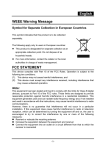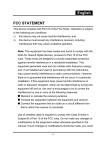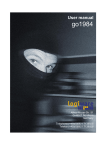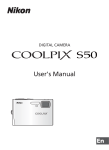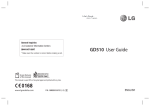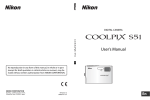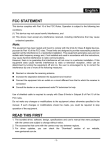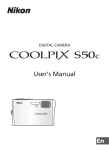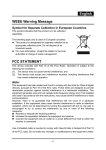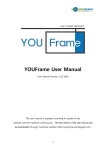Download English FCC STATEMENT Product Information
Transcript
English FCC STATEMENT This device complies with Part 15 of the FCC Rules. Operation is subject to the following two conditions: (1). This device may not cause harmful interference, and (2). This device must accept any interference received, including interference that may cause undesired operation. Note: This equipment has been tested and found to comply with the limits for Class B digital devices, pursuant to Part 15 of the FCC rules. These limits are designed to provide reasonable protection against harmful interference in a residential installation. This equipment generates uses and can radiate radio frequency energy and, if not installed and used in accordance with the instructions, may cause harmful interference to radio communications. However, there is no guarantee that interference will not occur in a particular installation. If this equipment does cause harmful interference to radio or television reception, which can be determined by turning the equipment off and on, the user is encouraged to try to correct the interference by one or more of the following measures: Reorient or relocate the receiving antenna Increase the separation between the equipment and receiver Connect the equipment into an outlet on a circuit different from that to which the receiver is connected Use of shielded cable is required to comply with Class B limits in Subpart B of Part 15 of the FCC rules. Do not make any changes or modifications to the equipment unless otherwise specified in the manual. If such changes or modifications should be made, you could be required to stop operation of the equipment. Product Information 1. Product design and specifications are subject to change without notice. This includes primary product specifications, software, software drivers, and user’s manual. This User Manual is a general reference guide for the product. 2. The product and accessories that come with your camera may be different from those -1- English described in this manual. This is due to the fact that different retailers often specify slightly different product inclusions and accessories to suit their market requirements, customer demographics, and geographical preferences. Products very often vary between retailers especially with accessories such as batteries, chargers, AC adapters, memory cards, cables, carrying cases/pouches, and language support. Occasionally a retailer will specify a unique product color, appearance, and internal memory capacity. Contact your dealer for precise product definition and included accessories. 3. The illustrations in this manual are for the purpose of explanation and may differ from the actual design of your camera. 4. The manufacturer assumes no liability for any errors or discrepancies in this user manual. 5. For driver updates, you can check the “Download” section of our website, www.geniusnet.com.tw. SAFETY INSTRUCTIONS Read and understand all Warnings and Cautions before using this product. Warnings If foreign objects or water have entered the camera, turn the power OFF and remove the batteries and the AC power adapter. Continued use in this state might cause fire or electric shock. Consult the store of purchase. If the camera has fallen or its case has been damaged, turn the power OFF and remove the batteries and the AC power adapter. Continued use in this state might cause fire or electric shock. Consult the store of purchase Do not disassemble, change or repair the camera. This might cause fire or electric shock. For repair or internal inspection, ask the store of purchase. Use the supplied AC adapter only with the indicated power supply voltage. Use with any other power supply voltage might cause fire or electric shock. -2- English Do not use the camera in areas near water. This might cause fire or electric shock. Take special care during rain, snow, on the beach, or near the shore. Do not place the camera on inclined or unstable surfaces. This might cause the camera to fall or tilt over, causing injury. Keep the batteries out of the reach of children. Swallowing batteries might cause poisoning. If the battery is accidentally swallowed, immediately consult a physician. Do not use the camera while you are walking, driving or riding a motorcycle. This might cause you to fall over or result in traffic accident. Cautions Insert the batteries paying careful attention to the polarity (+ or –) of the terminals. Inserting the batteries with its polarities inverted might cause fire and injury, or damage to the surrounding areas due to the battery rupturing or leaking. Do not fire the flash close to anyone’s eyes. This might cause damage to the person’s eyesight. Do not subject the LCD monitor to impact. This might damage the glass on the screen or cause the internal fluid to leak. If the internal fluid enters your eyes or comes into contact with your body or clothes, rinse with fresh water. If the internal fluid has entered your eyes, consult a physician to receive treatment. A camera is a precision instrument. Do not drop it, strike it or use excessive force when handling the camera. This might cause damage to the camera. Do not use the camera in humid, steamy, smoky, or dusty places. This might cause fire or electric shock. Do not remove the battery immediately after long period of -3- English continuous use. The battery becomes hot during use. Touching a hot battery might cause burns. Do not wrap the camera or place it in cloth or blankets. This might cause heat to build up and deform the case, resulting in fire. Use the camera in a well-ventilated place. Do not leave the camera in places where the temperature may rise significantly, such as inside a car. This might adversely affect the case or the parts inside, resulting in fire. Before you move the camera, disconnect cords and cables. Failure to do this might damage cords and cables, resulting in fire and electric shock. Notes on Battery Usage When you use the battery, carefully read and strictly observe the Safety Instructions and the notes described below: Use only the specified battery (NP60, 3.7V). Avoid using the battery in extremely cold environments as low temperatures can shorten the battery life and reduce digital video camera performance. When you are using the new rechargeable battery or rechargeable battery that has not been used for an extended period of time (the battery that passed the expiry date is an exception) might affect the number of images that can be captured. Therefore, to maximize its performance and lifetime, we recommend that you fully charge the battery and discharge it for at least one complete cycle before use. The battery may feel warm after long period of continuous use of the digital video camera or the flash. This is normal and not a malfunction. The digital video camera may feel warm after long period of continuous use. This is normal and not a malfunction. If the battery is not to be used for a long period of time, remove it from the digital video camera to prevent leakage or corrosion. If the battery is not to be used for a long period of time, store it after no battery power -4- English left. If the battery is stored for a long time in a fully charged state, its performance may be impaired. Always keep the battery terminals in a clean state. Risk of explosion if battery is replaced by an incorrect type. Dispose of used batteries according to the instructions. -5- English CONTENTS INTRODUCTION Capture Mode (Capturing Still Images) Setting the Scene Mode Setting the Flash Mode Using the Self-timer Continuous Capture 8-9 Overview Package contents GETTING TO KNOW THE CAMERA 10-17 PLAYBACK MODES Front view Rear view LED Indicators LCD Monitor Icons GETTING STARTED 18-28 Inserting the Battery Charging the Battery Using the AC Power Adapter Attaching the Hand Strap Inserting and Removing an SD Memory Card Using the LCD Monitor Turning the Power On/Off Choosing the Screen Language Setting the Date and Time Formatting Internal Memory or an SD Memory Card Setting Image Resolution and Quality AUDIO AND MP3 MODES 46-47 Audio Recording Audio and MP3 Playback MENU OPTIONS 48-55 Movie (Video) Menu Capture Menu Playback Menu (For Video and Still-Image) Playback Menu (For Audio and MP3) System Menu PHOTOGRAPHY MODES 38-46 Video Playback Still-Image Playback Playing Back Videos and Still Images on a TV Monitor Zoom Playback Thumbnail Display Protecting Videos and Images Deleting Videos and Images Slide Show Display Copying the contents of Internal Memory to a Memory Card 28-37 Movie mode (Recording Video Clips) Using the Digital Zoom Setting the exposure Value Setting the White Balance TRANSFERRING RECORDEDIMAGES, VIDEOS, AND AUDIO TO YOUR -6- English COMPUTER 55-57 (PICTBRIDGE Step 1: Installing the USB Driver (Windows 98/98SE users only) Step 2: Connecting the digital Video Camera to your computer Step 3: Downloading Images, video clips , and Audio FUNCTION) 60-63 INSTALLING AUTOPRODUCER 63 INSTALLING USING THE DIGITAL VIDEO VIDEOSTUDIO 64 CAMERA AS A WEB CAMERA 58-60 CONNECTING THE Step 1: Installing the Web camera Driver (same as USB driver) Step 2: Connecting the Digital video Camera to your computer Step 3: Run your application software ( i.e. Windows NetMeeting) DIGITALVIDEOCAMERA TO OTHER CONNECTING THE DIGITAL CAMERA DIRECTLY TO THE PRINTER FOR PRINTING IMAGE -7- DEVICES 65 SPECIFICATIONS 66-67 TROUBLESHOOTING 68-72 English INTRODUCTION Your new digital video camera is designed as a small handheld “entry-level” digital camcorder. Using the digital video camera record video and audio directly to memory (either internal memory, or a memory card) without using any tapes unlike a traditional camcorder. The digital video camera also delivers high quality digital still images using a 4.0 megapixel CCD sensor. An integral automatic flash sensor detects the shooting (lighting) conditions and determines whether the flash should be used. This feature helps ensure that your images turn out right. Another feature of the digital video camera is the ability to play MP3 files. The digital video camera has a small built-in speaker as well as a headphone jack for private listening. You may transfer MP3 files to your digital video camera from your PC using the USB cable, or you may wish to use a memory card and play your MP3s from the memory card. Finally, your digital video camera can also act as a voice recorder. An integral microphone enables you to record voice and other sounds to memory and play back those recordings at any time. Video clips or images that you have captured can be downloaded to your PC using the USB cable. You can enhance and retouch your video clips or images on your PC using the provided editing software. You may then share your creative media files with your friends via e-mail, in a report, or on a website. The 2.0" color image LCD monitor acts as a viewfinder for both still-image and video recording. After capturing your favorite moments you may review them in detail on the -8- English display. 8 MB of internal (built-in) memory lets you capture and store images without the immediate need for an additional memory card. However, you may wish to expand the memory capacity (up to 512 MB capacity) by using a Secure Digital (SD) external memory card. Package contents Carefully unpack your package and make sure that you have the following items. In the event that any item is missing or if you find any mismatch or damage, promptly contact your dealer. Digital video camera USB cable AV cable Software CD-ROM User’s manual Hand strap Quick guide Pouch AC Plug Adaptor for EU to US AC Power Adapter One Rechargeable Lithium Ion Earphone Battery Tripod NOTE Accessory and components may vary by different retailer. -9- English GETTING TO KNOW THE CAMERA Front view 1. Flash 2. Flash open button 3. Lens 4. Self-timer LED 5. SD memory card cover 6. Tripod socket 7. Battery Cover -10- English Rear view 1. 2. Power button Shutter / Pause button 3. Zoom control Zoom in Zoom out 4. Mode switch Preview mode Playback mode 5. Stop recording button 6. System LED 7. Battery charger LED 8. 9. Earphone jack A/V(Audio/Video output) jack 10. USB Port 11. DC IN 5V terminal 12. Strap eyelet 13. Microphone 14. Speaker 15. LCD panel/monitor 16. Delete button 17. (Mode) button 18. Stop playback button menu (Menu) button 19. set/Direction button -11- English Control Buttons 1. set (Set/Play/Pause) button 2. Up button Volume up button 3. Right/Fast forward button Self-timer button 4. Down button Volume down button 5. Left/Fast reverse button Flash button LED Indicators Indicator System LED State Description/Activity Solid green The digital video camera is powering up. Blinking green Blinking red Battery charge LED Self-timer LED 1. Image or video clips in progress. 2. USB communication in progress. 1. Charging the flash. 2. A system error is detected. Solid red The battery is charging. Blinking red The self-timer function is activated. -12- English LCD Monitor Icons Movie mode 1. 2. 3. 4. 5. 6. Movie mode icon Zoom status Battery power indicator [ ] Full battery power ] Medium battery power [ ] Low battery power [ ] Virtually no battery power [ SD memory card indicator [ ] An SD memory card is loaded [ ] No SD memory card is loaded [ ] SD memory card is full EV compensation White balance [AUTO] Auto [ [ ] ] 7. 8. FLUORESCENT-1 [ ] FLUORESCENT-2 [ ] NORMAL [ ] B&W (Black & White) [ ] SEPIA Video quality ] Super Fine [ ] Fine Normal [ ] 9. Video resolution [ ] 640 x 480 pixels ] 320 x 240 pixels [ 10. Available recording time (Before recording)/ Elapsed time (While recording) LAMP ] SHADE [ DAYLIGHT [ [ ] Color -13- English Capture mode 1. 2. 3. 4. 5. 6. Still image mode icon Zoom status Battery power indicator [ ] Full battery power ] Medium battery power [ ] Low battery power [ ] Virtually no battery power [ SD memory card indicator [ ] An SD memory card is loaded [ ] No SD memory card is loaded [ ] SD memory card is full Available number of shots Flash mode [ ] Automatic flash [ ] ISO100 [ ] Red-eye reduction [ ] ISO200 Forced flash [ ] ISO400 [ 7. ] 11. White balance 12. Color Single [ ] Scene ] [ 9. 10. EV compensation [ ] Flash off Capture mode icon [ 8. ] 13. Image quality Continuous [ AUTO [ ] Fine Normal [ ] [ ] SPORTS [ ] LANDSCAPE [ ] PORTRAIT [ ] BACKLIGHT [ ] NIGHT ] Super Fine 14. Image resolution [ ] 3350 x 2482 pixels (8MP, by interpolation) [ ] 2880 x 2160 pixels (6MP, by interpolation) [ ISO sensitivity [ ] ] 2320 x 1728 pixel (4MP, native resolution) Automatic -14- English [ ] 2048 x 1536 pixels [ ] 1600 x 1200 pixels [ ] 3-seconds delay ] 10-seconds delay [ 16. Main focus area ] 640 x 480 pixels [ 15. Self-timer indicator (if used) Audio Recording 1. Audio mode icon 2. Battery power indicator 3. SD memory card indicator 4. Recording indicator 5. Available recording time (Before recording)/ Elapsed time (While recording) -15- English Playback Mode – Video (Movie) Playback 1. Folder and file name 2. Duration of current video (Before playback)/ Elapsed time (During playback) 3. Video playback mode icon 4. Battery power indicator 5. SD memory card indicator 6. Playback indicator 7. Video status bar 8. Sound level (speaker volume) Low volume Mild volume Medium volume High volume Fully volume Mute (no sound) -16- English Playback Mode – Still-Image Playback 1. Still-image playback mode 2. Battery power indicator 3. SD memory card indicator 4. Folder and file name Audio and MP3 Playback Modes 1. / Audio/MP3 playback mode icon 2. File name 3. Battery power indicator 4. SD memory card indicator 5. Audio/MP3 status bar 6. Sound level (speaker volume) 7. Playback indicator 8. Play mode indicator Play one file Play all files Play the selected files 9. Repeat indicator 10. Elapsed time -17- English GETTING STARTED Installing the Battery We highly recommend using the specified rechargeable lithium-ion battery to realize the fully capability of your digital video camera. Charge the battery before using the digital video camera. Make sure that the power of the digital video camera is off before inserting or removing the battery. 1. Slide the battery cover in the direction of the [OPEN] arrow. 2. Insert the battery in the correct orientation, as shown. 3. Close the battery cover. Charging the Battery Using the optional AC power adapter may charge the battery or operate the digital video camera as power supply. Make sure that the power of the digital video camera is off and then insert the battery before starting. -18- English 1. Plug the AC power adapter into the “DC IN 5V” terminal of the digital video camera. 2. Insert the other end of the AC power adapter into a wall outlet. The battery charge LED lights red when charging is started and goes off when charging is completed. It is recommended that the battery be fully discharged before being recharged. Charging time varies according to the ambient temperature and the status of battery. NOTE This digital video camera must be used with the specified AC power adapter. Damage caused by the use of an incorrect adapter is not covered under the warranty. Always make sure that the digital video camera is off before removing the battery. The battery may feel warm after it has been charged or immediately after being used. This is normal and not a malfunction. When using the digital video camera in cold areas, keep the digital video camera and its battery warm by holding it inside your jacket or other warm protective environment. If you open the battery cover without removing the battery, the power will not be terminated. If you remove the battery, you must insert the (charged) battery within two hours in order to make sure that the date and time will not be reset. Using the AC Power Adapter Using an AC power adapter prevents the digital video camera from automatically powering off while transferring files to your computer. Note also the steps in the preceding section “Charging the Battery”. -19- English NOTE Make sure to use only the AC power adapter specified for the digital video camera. Damage caused by the use of an incorrect adapter is not covered under the warranty. Attaching the Camera Strap To prevent the accidental dropping of your digital video camera, attach and use the hand strap. Follow the illustration shown below. Inserting and Removing an SD Memory Card (Optional Accessory) The digital video camera comes with 8 MB of internal memory, allowing you to store images, videos, MP3 and audio files. You may expand the memory capacity and enjoy the convenience of added data portability by using an optional SD (Secure Digital) memory card. This allows you to store additional files and share them easily with other electronic devices you may already own. Inserting an SD memory card 1. Always make sure the digital video camera is turned off before inserting or removing -20- English a memory card. 2. Slide the SD memory card cover in the direction of the arrow. 3. Insert an SD memory card in the correct orientation as shown. Insert the card as far as it can go. You will hear and feel it click into place. Removing an SD memory card 1. Make sure the digital video camera is turned off. 2. Open the SD memory card cover. 3. Press lightly on the edge of the memory card and it will eject. NOTE To prevent valuable data from being accidentally erased from an SD memory card you can slide the write protect tab (on the side of the SD memory card) to “LOCK”. To save, edit, or erase data on an SD memory card, you must unlock the card. -21- English Using the LCD Panel 1. Open the panel by pulling it away from the digital video camera (A or B). 2. Choose the viewing angle that suits you best by rotating the panel. NOTE Rotate the LCD panel carefully and with the correct direction. Over rotation and rotation with the wrong direction may damage the hinge that connects the LCD monitor to the digital video camera. Avoid contact with the LCD monitor when moving the LCD panel. Do not hold the digital video camera by the LCD panel. -22- English Turning the Power On/Off 1. Load the battery or connect the AC power adapter to your digital video camera. 2. Press the button to turn on your digital video camera. To turn off your digital video camera, press again the button. NOTE The power is turned off automatically when the digital video camera has not been operated for a defined period time. To resume the operation condition, turn the power on again. Refer to section in this manual titled “POWER OFF” in the “SYSTEM MENU” for further details. Whenever the digital video camera is turned on, it may take several additional seconds to charge the flash capacitor. Choosing the Display Language Choose a language for information displayed on the LCD monitor. 1. Turn on your digital video camera. 2. Press the menu button. The MENU screen is displayed. 3. Move to [SYSTEM MENU] by using the button. 4. Select [LANGUAGE ] with the buttons, and press the / button. -23- English The LANGUAGE setting screen is displayed. 5. / Select the desired language using the buttons and press the button to confirm. Setting the Date and Time The date and time setting screen will automatically appear if/when: The digital video camera is turned on for the first time. The digital video camera is turned on after leaving it without the battery for an extended period of time. 1. Turn on your digital video camera. 2. Press the menu button. The MENU screen is displayed. 3. Move to [SYSTEM MENU] by using the 4. Select [DATE SETUP] with the / button. buttons, and press the button. The DATE SETUP setting screen is displayed. 5. Select the item’s field with the and time with the / / buttons and adjust the value for the date buttons. 6. After confirming all settings are correct, press the 7. Press MENU button to exit menu. -24- button. English Formatting Internal Memory or an SD Memory Card Formatting erases all images, videos, sound, MP3 files and folders that are stored on the SD memory card or internal memory. Formatting is not possible if an SD memory card is locked. Important Note: The digital video camera assigns preference to SD card memory. Whenever an SD memory card is inserted the digital video camera will automatically begin to use the SD card instead of internal memory. An SD memory card is not only assigned “first priority” but also exclusivity. Access to internal memory is not available when an SD card is used. If it appears that you cannot find your images and songs, try removing the SD card to again be able to “see” the internal memory. Only when the SD memory card is removed will internal memory be accessible. 1. Turn on your digital video camera. 2. Press the menu button. The MENU screen is displayed. 3. Move to [SYSTEM MENU] by using the button. 4. Select [FORMAT] with the / 5. Select [YES] with the buttons, and press the / buttons, and press the button. button to confirm. To cancel formatting, select [NO]. NOTE You should format an SD memory card before using it for the first time. Formatting will also erase protected images as all data is erased. Before formatting, -25- English make sure that all data is unnecessary. Formatting is an irreversible action and data cannot be recovered at a later time. An SD memory card having any problem cannot be properly formatted. Setting Image Resolution and Quality Resolution and quality settings determine the file size and compression ratio for your images and videos. These settings affect the number of images and videos that can be stored in memory, or on a memory card. High resolution and quality settings are recommended for printed output and situations requiring the finest detail. Lower resolution/quality images and videos take up less memory space and may be quite suitable for sharing via e-mail, in a report, or on a web page. To change image/video resolution or quality, perform these steps: 1. Turn on your digital video camera. 2. Slide the Mode switch to the 3. Press the side. button continuously until the Capture or Movie Mode appears. 4. Press the menu button. The CAPTURE or MOVIE MENU screen is displayed. 5. Select [SIZE] with the and press the / buttons, button to view the resolution choices. 6. Select the desired resolution with the buttons, and press the 7. Select [QUALITY] with the / button to confirm. / buttons, and press the -26- button to view the English quality choices. 8. Select the desired quality with the / buttons, and press the button to confirm. Possible number of shots (still image) This table shows approximate shots that you can capture at each setting based on the internal memory or an optional SD memory card. Resolution 3350 x 2482 2880 x 2160 2320 x 1728 2048 x 1536 1600 x 1200 8MB Internal Memory 128MB SD Memory SUPER FINE 1 23 FINE 3 46 NORMAL 5 69 SUPER FINE 2 30 FINE 4 61 NORMAL 7 92 SUPER FINE 3 47 FINE 7 95 NORMAL 10 144 SUPER FINE 4 61 FINE 9 121 NORMAL 13 182 7 99 FINE 14 196 NORMAL 22 294 Quality SUPER FINE -27- English 640 x 480 SUPER FINE 44 588 FINE 83 1092 NORMAL 116 1529 Possible recording time / sec (video clip) Resolution 640 x 480 320 x 240 8MB Internal Memory 128MB SD Memory SUPER FINE 00:20 5:04 FINE 00:25 6:18 NORMAL 00:30 7:32 00:40 9:59 FINE 1:00 14:48 NORMAL 1:19 19:28 Quality SUPER FINE * The data shows the standard testing results. The actual capacity varies according to the shooting conditions and settings. PHOTOGRAPHY MODES Movie Mode (Recording Video Clips) In this mode, you may record video clips. 1. Turn on your digital video camera. 2. Slide the Mode switch to the side. The default mode is Movie Mode. If not, press the -28- button continuously English until the Movie Mode appears. 3. Compose the image. If desired, you may use the Zoom control to compose the image. 4. Press the button. Video recording will begin. 5. Pressing the button again will pause recording. Pressing the button during pause will resume recording. Press the button to stop recording. NOTE When recording video clips, the flash and self-timer cannot be used. Using the Digital Zoom Zoom photography allows you to capture telephoto and wide-angle images. 1. Turn on your digital video camera. 2. Compose the image with the Zoom control. The subject appears closer by sliding the Zoom control to the side. The subject appears further away by sliding the Zoom control to the -29- side. English NOTE The digital zoom range is from 1x to 8x. Setting the Exposure Value Images can be captured with the overall scene intentionally made brighter or darker. These settings are used when a suitable brightness (exposure) cannot otherwise be obtained in circumstances where the difference in brightness between the subject and the background (the contrast) is large, or when the subject that you wish to capture is very small within the scene. Exposure can be set in 0.3 EV increments. 1. Turn on your digital video camera. 2. Slide the Mode switch to the 3. Press the side. button continuously until the Capture or Movie Mode appears. 4. Press the menu button. The CAPTURE or MOVIE MENU screen is displayed. 5. Select [EV] with the / buttons, and press the button to enter its submenu. Press the button to increase the value. Press the button to decrease the value. After selecting the exposure value, press the button to confirm. The range of exposure compensation is: -1.8, -1.5, -1.2, -0.9, -0.6, -0.3, 0, +0.3, -30- English +0.6, +0.9, +1.2, +1.5, +1.8. The larger the value, the brighter the image. The smaller the value, the darker the image. The selected EV is displayed on the LCD. Setting the White Balance The human eye adapts to changes in light so that white objects still appear white even when the light changes. With a digital video camera, however, the color of the subject is influenced by the color of the light surrounding it. This color adjustment is called “white balance adjustment”. This setting allows you to set the white balance when capturing images under specific lighting condition. 1. Turn on your digital video camera. 2. Slide the Mode switch to the 3. Press the side. button continuously until the Capture or Movie Mode appears. 4. Press the menu button. The CAPTURE or MOVIE MENU screen is displayed. 5. Select [AWB] with the / buttons, and press the button to view the white balance choices. 6. Select the desired mode with the / confirm. -31- buttons, and press the button to English Options on the White Balance menu: Icon AUTO Lighting conditions [AUTO] Automatically adjusts the white balance [DAYLIGHT] Outdoors on a bright day [LAMP] Tungsten lighting [FLUORESCENT-1] Fluorescent lighting [FLUORESCENT-2] Fluorescent lighting [SHADE] For overcast, shaded, twilight or evening skies Capture Mode (Capturing Still Images) In this mode, you may capture still images. 1. Turn on your digital video camera. 2. Slide the Mode switch to the 3. Press the side. button continuously until the Capture Mode appears. 4. Compose your image on the LCD monitor. If desired, you may use the Zoom control to compose the image. For detailed information on how to use digital zoom, please refer to the section in this manual titled “Using the Digital Zoom”. 5. Press the button to capture an image. -32- English Setting the Scene Mode This sets the scene mode for capturing images. 1. Turn on the digital video camera. Make sure the digital video camera is in Capture Mode. 2. Press the menu button. The CAPTURE MENU screen is displayed. 3. Select [SCENE] with the / buttons, and press the button to view the scene choices. 4. Select the desired mode with the / buttons, and press the button to confirm. Options on the Scene menu: Scene mode Description Select this mode when you want to leave the settings [AUTO] up to the digital video camera to capture images with ease. All flash modes can be set. Select this mode when you want to capture [SPORTS] fast-moving subjects. The flash is fixed at [ ]. Select this mode to enhance color, saturation shown in mountains, forests and other landscape scenery, or to [LANDSCAPE] take portraits that feature a landmark in the background. The flash is fixed at [ -33- ]. English Select this mode when you want to capture an image that makes the person stand out against a defocused [PORTRAIT] (blurred) background. The flash is fixed at [ ] which is effective in reducing the red-eye phenomenon. Select this mode while capturing images with the light [BACKLIGHT] coming from behind the subject. The flash is fixed at [ ]. Select this mode when you want to photograph people [NIGHT] with an evening or night scene background. The flash is fixed at [ ]. NOTE The description of each scene serves as a general guide. Set the digital video camera to suit your own preferences. The scene mode can be set only in Capture Mode. Setting the Flash Mode The flash is designed to function automatically when lighting conditions warrant the use of flash. You can capture an image using a flash mode suitable to your circumstances. 1. Press the Flash open button to open the Flash. 2. Turn on the digital video camera. Make sure the digital video camera is in Capture Mode. 3. Press the button repeatedly until the desired -34- English flash mode appears. 4. Compose the image and press the button. The table below will help you choose the appropriate flash mode: Flash mode Automatic flash Description The flash fires automatically according to the ambient lighting conditions. Select this mode for general flash photography. Use this mode to reduce the red-eye phenomenon when you want Red-eye reduction to capture natural-looking images of people and animals in low-light conditions. The flash will not fire. Select this mode when capturing images in a Flash off place where flash photography is prohibited, or when the distance to the subject is beyond the effective range of the flash. The flash always fires. Use this mode for photographing under Forced Flash artificial light such as backlighting, fluorescent lighting, etc. NOTE The flash cannot be used in Movie Mode. Using the Self-Timer Using the self-timer you can join into the scene when taking group shots. The self timer duration is ten or three seconds. 1. Turn on the digital video camera. Make sure the digital video camera is in -35- English Capture Mode. 2. Toggle the button to select the setting. Each press of the button moves the icon one step through the sequence and displays it on the screen. OFF → 3. 10 sec. → 3 sec. Compose the image, and then press the button. While the self-timer is activating, the or con displayed on the screen blinks. The Self-timer LED flashes and the image will be captured after the preset time has elapsed. The table below will help you choose the appropriate self-timer mode: Self-timer mode Description The image is captured about three seconds after the 3 seconds-delay shutter button is pressed. The image is captured about ten seconds after the shutter button is pressed. The Self-timer LED starts 10 seconds-delay blinking relatively slow for 7 seconds and then blinking rapidly for the last 3 seconds. -36- English NOTE The self-timer does not function in Movie Mode. The self-timer setting is automatically cancelled after an image is captured. Continuous Capture This function allows you to capture a sequential burst of three images with one press of the shutter button. The continuous capture mode is very useful for photographing objects in motion where it is difficult to determine the precise moment of capture. Afterwards, you may review the sequence of shots to select the best one. 1. Turn on the digital video camera. Make sure the digital video camera is in Capture Mode. 2. Press the button. When this function is enabled, the 3. Compose the image, and then press the icon will display on the LCD monitor. button. NOTE Continuous capture cannot not be activated while the image resolution is set to 8MP or 6MP. In continuous capture mode, the flash cannot be used. -37- English PLAYBACK MODES Video Playback You can play back video clips recorded on the digital video camera. You can also play back voice. 1. Turn on your digital video camera. 2. Slide the Mode switch to the 3. Press the side. button continuously until the Movie/Still-image Playback Mode appears. The last video clip/image appears on the screen. 4. Select the desired video clip or image with the / 5. buttons. Press the button to play the selected video clip. To pause playback at any time, press the button again. To stop playback, press the button. NOTE To adjust the volume of those videos that include audio, press the increase the volume, press the button to decrease the volume. -38- button to English Still-Image Playback You can view your still-images, enlarge them for detailed viewing, or run a slide show. 1. Turn on your digital video camera. Make sure the digital video camera is in Movie/Still-Image Playback Mode. The last video clip/image appears on the screen. 2. Select the desired video clip/image with the 3. Pressing the / rotated display. The whereas the / buttons. buttons during still-image playback will result in a 90 degree button rotates the image clockwise and displays it, button rotates the image counterclockwise and displays it. A press of the button opposite to the direction in which the image was rotated will return the image to the normal display. Playing Back Videos and Still Images on a TV Monitor You can also play back your videos and images on a TV screen. Before connecting to any video device, however, make sure to select, on the digital video camera, the video broadcast standard (NTSC or PAL) which matches the video broadcast standard of the video equipment you are going to connect to the digital video camera. It is also recommended that you use an AC power adapter while viewing your images and video files on a TV monitor. 1. Plug one end of the A/V cable into the A/V OUT terminal of the digital video camera. 2. Connect the other end to the Audio and Video input jacks on your TV Monitor. It is -39- English important to note that the yellow RCA jack is the video signal and the other RCA jacks (usually red and black) are audio (left and right channels). 3. Turn on your TV and the digital video camera. 4. Command the digital video camera to play back still images or videos, as desired, as discussed in the previous sections. The method of playback operation is the same as playing back still images and video clips on the digital video camera itself. Zoom Playback You may enlarge your still images to view the finer details. You may zoom up to 8 times the normal display size. 1. Turn on your digital video camera. Make sure the digital video camera is in Movie/ Still-Image Playback Mode. The last video clip/image appears on the screen. 2. Select the image you want to enlarge with the 3. Adjust the zoom ratio with the Zoom control. / buttons. side will enlarge the image. Sliding the Zoom control to the The image is displayed enlarged. You will see a white frame with a red box inside. The white frame indicates the entire image, while the red box shows the location -40- English of the currently enlarged area. 4. Select the area of enlargement with the 5. Slide the Zoom control to the / / / buttons. side repeatedly until the regular size appears on the screen. NOTE The zoom playback ratio for still images is from 1x to 8x. The zoom playback function is not available while playing back video clips. Thumbnail Display This function allows you to view nine thumbnail images on the LCD monitor simultaneously, so you can quickly search for the image that you want. 1. Turn on your digital video camera. Make sure the digital video camera is in Movie/ Still-Image Playback Mode. The last video clip/image appears on the screen. 2. Slide the Zoom control to the side once. The images are displayed in the thumbnail display. Images that have been selected with the / / / buttons will be indicated by a green frame. 3. Press the / buttons to select the image to be displayed at regular size. -41- English 4. To return to thumbnail display, slide the Zoom control to the side again. Protecting Videos and Images You can protect your video clips and images from accidental deletion by selecting the PROTECT function in the Movie/Still-Image Playback Mode. Follow these steps to protect an image or video. 1. Turn on your digital video camera. Make sure the digital video camera is in Movie/ Still-Image Playback Mode. 2. Select the image you wish to protect with the / 3. buttons. Press the menu button. The PLAYBACK MENU screen is displayed. 4. Select [PROTECT] with the 5. Press the / / buttons, and press the button. buttons to select [ONE FILE], and then press the To protect all images and video clips, select [ALL FILE] in this step. 6. “ONE FILE” appears on the image. 7. Select [LOCK] with the / buttons. Press the set button to confirm. Once the video clip/image is protected, the displayed on each protected video and image. -42- (protection) icon will be button. English Canceling protection To cancel protection for an image or video clip, display the image or video for which you wish to remove the protection. 1. Perform the above steps 1~6. 2. Select [UNLOCK] with the / buttons. Press the button to confirm. Deleting Videos and Images You may selectively delete any unprotected image or video from your digital video camera. To delete videos or images from internal memory, remember to remove your SD memory card. To delete one video or image 1. Turn on your digital video camera. Make sure the digital video camera is in Movie/ Still-Image Playback Mode. 2. Select the unwanted video or image with the / buttons. button. 3. Press the 4. “ONE FILE” appears on the image. 5. Select [YES] with the / buttons. Press the button to confirm. If you wish to cancel the deletion, select [NO]. 6. Repeat the above steps to delete additional videos and images. If all videos and images have been deleted, “NO FILE!” will display. -43- English To delete all videos or images at once 1. Perform the above step 1. 2. Press the menu button. The PLAYBACK MENU screen is displayed. 3. Select [DELETE ALL] with the button. buttons, and press the 4. Select [YES] with the / / buttons. Press the button to confirm. If you wish to cancel the deletion, select [NO]. If all videos and images have been deleted, “NO FILE!” will display. Slide Show Display The slide show function enables you to play back your images automatically in sequential order as a slide show. This is a very useful and entertaining feature for reviewing recorded images and for presentations. 1. Turn on your digital video camera. Make sure the digital video camera is in Movie/ Still-Image Playback Mode. 2. Press the menu button. The PLAYBACK MENU screen is displayed. 3. Select [SLIDE SHOW] with the / buttons, and press the -44- button. English 4. Set the playback interval with the / buttons. Press the button to confirm the interval. The slide show presents your images on the LCD monitor, one by one, with the interval that you set. To stop the slide show display, press the button. NOTE The POWER OFF function is disabled while playing a slide show. Copying the Contents of Internal Memory to a Memory Card This feature allows you to copy your images, videos or audios from the digital video camera’s internal memory to an SD memory card. Of course, you can do this only if you have an SD memory card installed and some data in internal memory. To copy files from internal memory to SD memory card, follow the steps below: 1. Make sure the digital video camera is powered off, and then insert the SD memory card. 2. Turn on the digital video camera. 3. Press the menu button. The MENU screen is displayed. 4. Move to [SYSTEM MENU] by using the -45- button. English The [SYSTEM MENU] screen is displayed. / buttons, and press the 5. Select [COPY TO CARD] with the 6. To proceed with the copying process, select [YES] with the / button. buttons, and button to confirm. The display indicates copying is in progress; press the once finished, you return to the [SYSTEM MENU] screen. NOTE It is not possible to copy from SD memory card to internal memory. AUDIO MODE AND MP3 MODES This digital video camera allows you to record and play audio files anytime and anywhere. Audio Recording 1. Turn on your digital video camera. 2. Slide the Mode switch to the 3. Press the 4. Press the side. button continuously until the Audio Recording Mode appears. button to start recording. Audio recording will begin. 5. Pressing the button again will pause recording. Pressing the button during pause will resume recording. Press the button to stop recording. -46- English Audio and MP3 Playback 1. Turn on your digital video camera. 2. Slide the Mode switch to the 3. Press the 4. Select the page number with the side. button continuously until the Audio/MP3 Playback Mode appears. / buttons. 5. Select the desired audio/MP3 file with the / 6. buttons. button to start playing. Press the Pressing the button again will pause playback. Pressing the Press the button during pause will resume playback. button to increase the volume, press the button to decrease the volume. 7. Press the 8. To delete an MP3 or audio file, press the button to stop playback. screen. Select [YES] with the / button. “ONE FILE” appears on the buttons. Press the To cancel the deletion, select [NO] instead. -47- button to confirm. English MENU OPTIONS MOVIE (VIDEO) MENU Use this menu to select video resolution, video quality, color, exposure value, and white balance. AWB For information about white balance, please refer to the section in this manual titled “Setting the White Balance”. SIZE Sets the desired video resolution. 640x480: 640 x 480 pixels 320x240: 320 x 240 pixels EV For information about exposure value, please refer to the section in this manual titled “Setting the Exposure Value”. QUALITY Sets the quality (compression rate) at which the video is to be recorded. SUPER FINE: Low compression rate FINE: Normal NORMAL: High compression rate -48- English COLOR Sets the color at which the video is to be recorded. NORMAL: Normal color B&W: Black & White SEPIA: Sepia CAPTURE MENU You can use this menu to select still-image resolution, quality, and color. You may also adjust exposure value, white balance, and ISO. AWB For information about white balance, please refer to the section in this manual titled “Setting the White Balance”. SIZE Sets the desired image resolution. 3350x2482: 3350 x 2482 pixels (8MP, by interpolation) 2880x2160: 2880 x 2160 pixels (6MP, by interpolation) 2320x1728: 2320 x 1728 pixels (4MP, native resolution) 2048x1536: 2048 x 1536 pixels 1600x1200: 1600 x 1200 pixels 640x480: 640 x 480 pixels -49- English EV For information about exposure value, please refer to the section in this manual titled “Setting the Exposure Value”. QUALITY Sets the quality (compression rate) at which the still image will be compressed and stored as JPG files. SUPER FINE: Low compression rate FINE: Normal NORMAL: High compression rate COLOR Sets the image color. NORMAL: Normal color B&W: Black & White SEPIA: Sepia SCENE For information about scene mode, please refer to the section in this manual titled “Setting the Scene Mode”. ISO You may select the preferred photographic ISO for image capture. The higher the ISO sensitivity value the greater sensitivity, but with increased noise. With a higher sensitivity, image can be captured with less light. [AUTO]: Automatic adjustment [100]: Sensitivity equivalent to ISO100 [200]: Sensitivity equivalent to ISO200 [400]: Sensitivity equivalent to ISO400 -50- English DATE PRINT The capture date can be printed directly on your still images. This function must be activated before the image is captured. YES: Imprints the date on the still images when capturing images. NO: Does not imprint the date on the still images when capturing images. PLAYBACK MENU (For Video and Still-Image) Use this menu to create an on-camera slide show. You can also use the playback menu to protect or delete one or all images. SLIDE SHOW Automatically plays back still images sequentially at a selected interval: 3 SEC, 5 SEC, 7 SEC, or 9 SEC. PROTECT You may protect images and videos from accidental erasure. Refer to the section in this manual titled “Protecting Videos and Images” for further details. DELETE ALL Please refer to the section in this manual titled “Deleting Videos and Images” for further details. -51- English PLAYBACK MENU (For Audio and MP3) Use this menu to play selected audio or MP3 files repeatedly or delete all the files. PLAY MODE SINGLE: Play only one audio or MP3 file. SELECT: Play the selected audio or MP3 files. ALL: Play all audio or MP3 files. REPEAT YES: Repeatedly play your audio or MP3 files according to your preferences. NO: Play the listed files only once. DELETE SELECT: Delete the selected audio or MP3 file. ALL: Delete all audio or MP3 files in a single operation. -52- English SYSTEM MENU LANGUAGE This option allows you to select the language for the menus and the text displayed on the LCD monitor. Refer to the section in this manual titled “ Choosing the Display Language” for further details. FORMAT This option formats the internal memory (or SD memory card) and erases all stored images and data. Please refer to the section in this manual titled “Formatting Internal Memory or an SD Memory Card” for further details. LCD BRIGHT Adjusts the LCD monitor’s brightness from [+5] to [-5]. DATE TYPE Sets the date type. Y/M/D: Year/Month/Day D/M/Y: Day/Month/Year M/D/Y: Month/Day/Year DATE SETUP After removing the batteries from the digital video camera, the date and time may return to the default settings. If this happens, reset the date and time when using the digital video camera. Refer to the section in this manual titled “Setting the Date and Time” for further details. -53- English POWER OFF If the digital video camera goes unused for a certain period of time while the digital video camera is powered on, it will switch to idle mode, and eventually turn itself off to conserve power. If the digital video camera is idle, re-activate it by pressing any button. If the digital video camera has powered-off, then you must turn it on again by pressing the button. Use the / buttons to select the power-off interval, then press the button to confirm. The power-off interval has four options: 3 MIN, 5 MIN, 10 MIN, OFF (power-off is disabled). COPY TO CARD Please refer to the section in this manual titled "Copying the Contents of Internal Memory to a Memory Card" for further details. VIDEO OUT Sets the video output format (broadcast standard) for displaying recorded images and video clips on a television. NTSC: NTSC broadcast standard. PAL: PAL broadcast standard. BEEP Enables or disables the sounds (beeps) associated with digital video camera button functions. ON: Enables sounds/beep tones. OFF: Disables sounds/beep tones. RESET This returns all basic settings to the digital video camera’s default values. The time setting will not be reset. -54- English NO: Does not return to the default settings and the current settings are retained, unchanged. YES: Returns the digital video camera to the original factory (default) settings. TRANSFERRING RECORDED IMAGES, VIDEOS, AND AUDIO TO YOUR COMPUTER To transfer images/videos/audio from the digital video camera to your computer, follow these steps: Step 1: Installing the Windows 98 USB driver Step 2: Connecting the digital video camera to your computer Step 3: Downloading images, videos, and audio System Requirements (Windows) Pentium 600 MHz or higher Windows 98SE/Me/2000/XP 128 MB RAM 128 MB hard disk space CD-ROM drive Available USB port Step 1: Installing the USB driver on Windows computers The USB driver on the CD-ROM is exclusively for computers running Windows 98 Second Edition. Installing the USB driver on computers running Windows 2000/ME/XP is neither necessary, nor recommended. -55- English 1. Insert the CD-ROM that came with the digital video camera into your CD-ROM drive. The welcome screen appears. 2. Click “Install USB/PC-Cam Driver”. Follow the onscreen instructions to complete the installation. After the USB driver has been installed, restart your computer. Step 2: Connecting the Digital Video Camera to your computer 1. Connect one end of the USB cable to an available USB port on your computer. 2. Connect the other end of the USB cable to the USB port on the digital video camera. 3. Turn on your digital video camera. [USB MODE] menu appears on the screen. 4. Select [MASS STORAGE] with the buttons, and then press the 5. / button. From the Windows desktop, double click on “My Computer”. 6. Look for a new “Removable disk” icon. This “Removable disk” is actually the internal memory or the SD memory card in your digital video camera. Typically, the digital video camera will be assigned drive letter “e” or higher. 7. Double click on the removable disk and locate the DCIM, MP3 and AUDIO folder. -56- English 8. Double click on the folders to open it to find more folders. Your recorded images, videos, and audio will be inside these folders. Copy, Paste or Drag-N-Drop images, videos, and audio to a folder on your computer. NOTE When connecting to the computer, it is necessary to install the battery or use an AC power adapter. Step 3: Downloading images/video clips When the digital video camera is turned on and connected to your computer, it is considered to be a disk drive, just like a floppy disk or CD. You can download (transfer) files by copying them from the “Removable disk” (“untitled” or “unlabeled” disk on a Macintosh) to your computer hard drive. Windows Open the “removable disk” and subsequent folders by double clicking on them. Your images, videos, and audio are inside these folder(s). Select the files that you want, and then choose “Copy” from the “Edit” menu. Open the destination location (folder) and choose “Paste” from the “Edit” menu. You may also drag and drop files from the digital video camera to a desired location. NOTE For transferring MP3 files, simply copy the MP3 files from your computer hard drive to the “MP3” folder. Memory card users may prefer to use a memory card reader (highly recommended). Video playback application is not included with the package. Make sure that video playback application has been installed in your computer. -57- English USING THE DIGITAL VIDEO CAMERA AS A PC CAMERA Your digital video camera can act as a web camera, which allows you to videoconference with business associates, or have a real-time conversation with friends or family. To use the digital video camera as a web camera, follow these steps: Step 1: Installing the web camera driver (same as USB driver). Step 2: Connecting the digital video camera to your computer. Step 3: Running your application software (i.e. Windows NetMeeting). NOTE Video conferencing software is not included with the digital video camera. This mode is not supported for Mac. General system requirements for videoconference To use the digital video camera for videoconference, your computer system must include: Microphone Sound card Speakers or headphones Network or Internet connection -58- English Step 1: Install the Web camera driver (same as USB driver) The web camera driver included on the CD-ROM is exclusively for Windows. The web camera function is not supported for Mac platforms. 1. Insert the CD-ROM that came with the digital video camera into your CD-ROM drive. The welcome screen appears. 2. Click “Install USB/PC-Cam Driver”. Follow the on-screen instructions to complete the installation. After the driver installation is completed, restart your computer. NOTE The USB driver that bundled inside the CD-ROM is designed in a form 2 in 1 (USB & web camera driver). a) On Windows 98SE, the Windows OS will install both USB & web camera drivers. b) On Windows 2000/ME/XP, it will only install web camera driver. Step 2: Connecting the Digital Video Camera to your Computer 1. Connect one end of the USB cable to the USB port on the digital video camera. 2. Connect the other end of the USB cable to an available USB port on your computer. 3. Turn on the digital video camera. [USB MODE] menu appears on the screen. 4. Select [WEBCAM] with the buttons, and press the / button. -59- English 5. Position the digital video camera steadily on top of your computer monitor or use a tripod. NOTE When using this digital video camera as a web camera, it is necessary to install the battery or use an AC power adapter. Step 3: Run your application software (i.e. Windows NetMeeting) To use Windows NetMeeting for videoconferencing: 1. Go to Start → Programs → Accessories → Communications → NetMeeting to launch the NetMeeting program. 2. Click the Start Video button to view live video. 3. Click the Place Call button. 4. Type the e-mail address or the network address of the computer that you are calling. 5. Click Call. The person that you are calling must also have Windows NetMeeting running and be willing accept your call to start the videoconference. NOTE The video resolution for videoconferencing applications is generally 320 x 240. For more information about the operation of videoconference application software, refer to its respective help documentation. CONNECTING THE DIGITAL VIDEO CAMERA DIRECTLY TO THE PRINTER FOR PRINTING IMAGES (PICTBRIDGE FUNCTION) -60- English If a printer that supports PictBridge is available, images can be printed by connecting the digital video camera directly to the PictBridge-compatible printer without using a computer. 1. Connect the digital video camera to the printer using the USB cable. 2. Turn on the printer and digital video camera. [USB MODE] menu appears on the screen. 3. Select [PICTBRIDGE] with the buttons, and then press the 4. / button. Select [SIZE] or [BORDERLESS] with the / the buttons and select its print type with / buttons. Then press the button to confirm the selection. [SIZE]: You may select the desired item according to the type of printer being used. [BORDERLESS]: You may select the desired item according to the type of printer being used. 5. Select the image that you want to print with the / buttons, and then press the button to set more detailed print settings. -61- English 6. Select [PRINT NUMBER], [DATE] or [FILE NAME] with the / buttons and change / their settings with the buttons. Then button to confirm the selection. press the [PRINT NUMBER]: Select the number of frame to be printed up to 10. [DATE]: Select [WITH] to print the image with date imprint. [FILE NAME]: Select [WITH] to print the image with file name. 7. Use the press the / buttons to select [PRINT]. Then button to confirm the print settings and start printing. 8. The printing starts and the figure shown on the right hand side appears until the printing is complete. 9. To cancel printing, press the button while the printing is proceeding. A selection screen appears. Use the / buttons to select [CANCEL]. Then press the button to cancel printing. -62- English NOTE It is recommended using the AC power adapter while connecting the digital video camera to the printer with the USB cable. Even if the digital video camera is connected to the printer with USB cable, the power is not supplied via USB cable. INSTALLING AUTOPRODUCER Muvee™ autoProducer is the fastest, easiest and most fun way to transform your videos into slick productions. It takes one minute to learn and is typically a hundred times faster than any other video editing software. Simply give the program your video, add in some music, select an editing style, and it does the rest! Create myriad different productions instantly - each one in a radically different style, and with a polished, professional feel. To Install autoProducer: 1. Insert the CD-ROM packaged with the digital video camera into the CD-ROM drive. The welcome screen appears. 2. Click “Install Muvee Auto Producer”. Follow the on-screen instructions to complete the installation. NOTE For information on how to use Muvee™ autoProducer, please refer to its online help. For Windows 2000/XP users, please make sure to install and use the autoProducer in "Administrator" mode. Muvee™ autoProducer is PC compatible only. -63- English INSTALLING VIDEOSTUDIO Ulead® VideoStudio is home video-editing software that makes editing movies as fun as shooting them. Users can make one in three easy steps using the new Movie Wizard mode. VideoStudio features fully customizable filters and special effects and shares finished projects on diversified devices by supporting the latest formats. To install VideoStudio: 1. Insert the CD-ROM that came with the digital video camera into your CD-ROM drive. The welcome screen appears. 2. Click “Install Ulead® VideoStudio”. Follow the onscreen instructions to complete the installation. NOTE For more information about the operation of VideoStudio application software, refer to its respective help documentation. For Windows 2000/XP users, please make sure to install and use the VideoStudio in “Administrator” mode. VideoStudio is not supported on the Mac. -64- English CONNECTING THE DIGITAL VIDEO CAMERA TO OTHER DEVICES -65- English SPECIFICATIONS Item Description Image sensor 4 Mega pixels CCD Sensor 3350 x 2482 pixels (8MP, by interpolation) 2880 x 2160 pixels (6MP, by interpolation) 2320 x 1728 pixels (4MP, native resolution) 2048 x 1536 pixels 1600 x 1200 pixels 640 x 480 pixels Image resolution Video resolution VGA 640 x 480/QVGA 320 x 240 Image/Video quality SUPER FINE/FINE/NORMAL LCD monitor 2.0” Color TFT LCD Lens Memory type Self-timer ISO sensitivity Digital zoom Compression format Focal length: 7.60 mm F-no: 3.5/7.0 8 MB internal memory SD memory card support (optional, up to 512 MB capacity) 3-seconds delay/10-seconds delay Equivalent to ISO 100/200/400/Auto (ISO 100 - ISO 400) 1x ~ 8x for Still-image playback mode 1x ~ 8x for Still-image and Movie (Video) capture mode Still image: JPEG Video: MPEG4 (ASF file) Audio: IMA-ADPCM Video standards NTSC/PAL Flash Automatic/Red-eye reduction/Forced flash/Flash off Exposure compensation +/- 1.8 EV (in 0.3 EV increments) White balance AUTO, DAYLIGHT, LAMP, FLUORESCENT-1, -66- English FLUORESCENT-2, SHADE Power Rechargeable lithium-ion battery, NP-60/3.7V (optional),AC power adapter, 5V/3A (optional) Headphone jack Interface A/V OUT terminal USB port (USB 2.0/B-mini) DC IN 5V terminal Dimensions Approx. 109.6 x 35.5 x 55 mm Weight Approx. 147g (without the battery & SD memory card) * Design and specifications are subject to change without notice. -67- English TROUBLESHOOTING Refer to the symptoms and measures listed below before sending the digital video camera for repairs. If the problem persists, contact your local reseller or service center. Power Supply Symptom The power does not come on. The power cuts out during use. Cause The battery is not loaded. Load the battery correctly. The battery is exhausted. Recharge or use the AC power adapter. The AC power adaptor is not connected correctly. The digital video camera was left unattended and unused, so the auto powers off cuts it off. The battery is exhausted. The power does not go off. The battery runs out quickly. The battery or digital video camera feels warm. Measure Digital video camera malfunction. It is being used in extreme low temperature. Many images are being captured in dark places inside, requiring flash. The battery is not fully charged. The battery is not used for an extended period of time after charged. Long period of continuous use of the digital video camera or the flash. -68- Reconnect it properly. Turn the power back on. Recharge or use the AC power adapter. Reload the battery. If using the AC power adapter, reconnect it. Fully charge the battery and discharge it for at least one complete cycle before use to maximize its performance and lifetime. English Shooting Symptom Cause Even if I press the shutter button, the digital video camera does not shoot. The battery is running low. Images do not appear on the LCD monitor. Measure Recharge or use the AC power adapter. Turn the power on. Slide the mode switch to shooting mode. Press the shutter button all the way. The power is not on. The digital video camera is not in shooting mode. The shutter button is not pressed all the way. The internal memory or memory card does not have any free space. End of memory card life. Load a new memory card. The flash is recharging. Wait until the system LED off. The memory card is unrecognized by the digital video camera. Format the memory card in this digital video camera before its first use or when it was used other than this digital video camera. The auto power off function is activated. The power is not on. The LCD monitor is dark. Although it is set to Auto Focus, it does not focus. The lens or Self-timer LED is dirty. The distance to the subject is smaller than the effective range. The flash does not fire. The flash cannot recharge. The digital video camera is set to / / / mode. The flash is set to flash off. -69- Load a new memory card, or delete unwanted files. Turn the power on again. Turn the power on. Adjust the brightness of the LCD monitor in the SYSTEM MENU. Wipe clean with a soft, dry cloth or lens paper. Get your subject within the effective focus range. Switch the capture mode to someone other than one of those. Set the flash to something other than flash off mode. English Symptom Cause Measure Even though the flash fired, the image is dark. The distance to the subject is greater than flash effective range. Get closer to your subject and capture. The image is too dark. The image was captured in a dark place while set to flash off. Set the flash to something other than flash off mode. It is under-exposed. Set the exposure compensation to a larger value. The image is too bright. It is over-exposed. Set the exposure compensation to a smaller value. The image lacks natural color. The image was captured in conditions that are hard for Auto White Balance to adjust to. Add a white object to the composition. -70- English Playback Symptom Cause Measure Cannot playback. It is not set to playback mode. You played back a memory card that was not formatted by this device. Slide the mode switch to playback mode. Loaded a card that was formatted and stored on by this device. The file is protected. Cancel protection. You played back a memory card that was not formatted by this device. The memory card is writeprotected. End of memory card life. Loaded a card that was formatted and stored on by this device. Remove the writeprotection. Load a new memory card. The LCD monitor is too dark. Adjust the brightness of LCD monitor in the SYSTEM MENU. Symptom Cause Measure Cannot load the memory card. Even when the digital video camera’s buttons are pressed, it does not operate. The card is facing the wrong way. Load correctly. The date and time is wrong. The correct date and time is not set. Set the correct date and time. The date set has disappeared. The battery is removed with the power still on. Set the date and time again. The contents of memory card cannot be replayed. Files cannot be deleted. Cannot format a memory card. The playback image is dark though I used the flash. Other Problems The battery is running low. Digital video camera malfunction. -71- Recharge or use the AC power adapter. Turn the power off and remove the battery once, and try again. English About connecting to your computer/software Symptom Cause Measure Cannot download files. The free space on the hard Check whether the hard disk drive of your computer disk drive has enough may be insufficient. space for running Windows, and if the drive for loading files has a capacity at least that of the memory card inserted in the digital video camera. No power supply. Recharge the battery or use the AC power adapter or turn the power on. The USB driver is not installed (for Windows 98/98SE). -72- Install USB driver.








































































